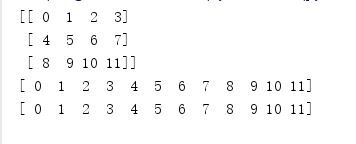python将二维数组升为一维数组 或 二维降为一维
文章目录
-
- 1. 二维(多维)数组降为一维数组
- 2. 一维数组升为 2 维数组
1. 二维(多维)数组降为一维数组
方法1: reshape()+concatenate 函数,
- 这个方法是间接法,利用 reshape() 函数的属性,间接的把二维数组转换为一维数组;
import numpy as np
mulArrays = np.array([[1, 2, 3], [4, 5, 6], [7, 8, 9]])
print(list(np.concatenate(mulArrays.reshape((-1, 1), order="F"))))
Out[1]:
[1, 4, 7, 2, 5, 8, 3, 6, 9]
方法2: flatten() 函数,
推荐使用这个方法,这个方法是numpy自带的函数;
# coding = utf-8
import numpy as np
import random
# 把二维数组转换为一维数组
t1 = np.arange(12)
print(t1)
Out[0]: [ 0 1 2 3 4 5 6 7 8 9 10 11]
t2 = t1.reshape(3, 4)
print(t2)
t3 = t2.reshape(t2.shape[0] * t2.shape[1], )
print(t3)
t4 = t2.flatten()
print(t4)
运行效果如下图所示:

可以看到这两种方式都可以把二维数组转换为一维数组,但是推荐使用 flatten() 函数,该方法也可以将多维数组转换为一维数组。
import numpy as np
a = np.array([[1, 2], [3, 4], [9, 8]])
b = a.flatten()
print(b)
输出结果为:[1, 2, 3, 4, 9, 8]
方法3: itertools.chain
import numpy as np
a = np.array([[1, 2], [3, 4], [9, 8]])
# 使用库函数
from itertools import chain
a_a = list(chain.from_iterable(a))
print(a_a)
输出结果为:[1, 2, 3, 4, 9, 8]
方法4: sum()
mulArrays = [[1, 2, 3], [4, 5, 6], [7, 8, 9]]
print(sum(mulArrays, [])) # [1, 2, 3, 4, 5, 6, 7, 8, 9]
方法5:operator.add + reduce
import operator
from functools import reduce
mulArrays = [[1, 2, 3], [4, 5, 6], [7, 8, 9]]
print(reduce(operator.add, mulArrays)) # [1, 2, 3, 4, 5, 6, 7, 8, 9]
方法6:列表推导式
mulArrays = [[1, 2, 3], [4, 5, 6], [7, 8, 9]]
print([i for arr in mulArrays for i in arr]) # [1, 2, 3, 4, 5, 6, 7, 8, 9]
2. 一维数组升为 2 维数组
方法1:numpy 方法
利用函数 reshape 或者是 resize。
使用 reshape 的时候需要注意 reshape 的结果不改变,因此适用于还要用到原数组的情况。
使用 resize 会改变原数组,因此适用于一定需要修改后的结果为值的情况。
import numpy as np
x = np.arange(20) # 生成数组
print(x)
result = x.reshape((4, 5)) # 将一维数组变成4行5列 原数组不会被修改或者覆盖
x.resize((2, 10)) # 覆盖原来的数据将新的结果给原来的数组
print(x)
输出结果
[ 0 1 2 3 4 5 6 7 8 9 10 11 12 13 14 15 16 17 18 19]
[[ 0 1 2 3 4 5 6 7 8 9]
[10 11 12 13 14 15 16 17 18 19]]